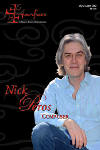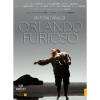Texte paru dans: / Appeared in:

Fanfare Magazine 35:6 (07-08/2012)
Pour
s'abonner / Subscription information
Les abonnés à Fanfare Magazine ont accès aux archives du
magazine sur internet.
Subscribers to Fanfare Magazine have access to the archives of the magazine
on the net.
Naïve
RV728 (DVD)

0822186021484
Consultez toutes les évaluations recensées pour ce cd
~~~~ Reach all the evaluations located for this CD
It’s not often, anymore, that I will go out of my way to watch or listen to a Baroque opera performance. The rather fixed, inflexible format, repetitious arias, and rattletrap orchestral accompaniments simply don’t appeal to me the way they did when I was in my 20s and early-30s. (Someone might make a sociological study of this: Why does Baroque opera appeal more to younger listeners? And at what stage does one usually grow out of it, pull up short and say, “You know, all of this stuff sounds alike”?) I opted for this one because of some of the artists involved, specifically Jennifer Larmore, who is a terrific actress as well as a singer, and conductor Jean-Christophe Spinosi, who created absolute magic out of Rossini’s very routine, youthful opera La pietra del paragone.
The singers sing their hearts out and, more interestingly, they all act very well on stage. Director Pierre Audi quite obviously put a lot of thought and work into how he wanted the opera to play out on stage. As I expected, Larmore is terrific as Alcina; Verónica Cangemi presents a believably angst-ridden, lovestruck Angelica; Marie-Nicole Lemieux is surprisingly good, especially from a dramatic standpoint, as Orlando (and boy, is he furious!); and Spinosi conducts with his usual vigor and brio. Although I’ve come to the point where I’m almost allergic to countertenors in Baroque opera (they simply weren’t there in the 18th century, and they make a very poor substitute, by and large, for castrati), if you’re going to have one, it had better be someone of the caliber of David Daniels or Philippe Jaroussky, and the latter performs the role of Ruggiero extremely well here.
Yet in the end, I am not convinced of the verity of the work. Even though Larmore as Alcina sings her arias of anger or vengeance right in the faces of her protagonists, and though her face mirrors her emotional state, you just can’t escape the impression that she, like all the other singers, in the end is only performing vocal gymnastics. Yes, the same was true of the Rossini opera, but at least that was funny. (Ironically, baritone Christian Senn appears in both videos.) This one tries to be as serious as a tornado, but inevitably you almost expect Shannon Miller or Mary Lou Retton to step out and nail a 10 on the balance beam while singing one of these arias.
The booklet proclaims this work the “operatic masterpiece” of Vivaldi, but for me the problem with Vivaldi’s vocal writing is that it isn’t particularly interesting, melodically or harmonically. (Orlando’s first-act aria, with its occasional out-of-center chords and two-octave leaps, is a rare exception.) And my lord, it goes on seemingly forever. Even the slow arias tend to sound generic for the style and era. I am also rather disenchanted by the extraordinarily dark stage sets—so dark, in fact, that most of the time you need a flashlight just to see the singers. Come on, lighting director, give us a little better glimpse of them than this! But no, he doesn’t even relent a little bit for acts II or III.
If you enjoy this kind of music, however, the audio portion will thrill you. Everything is indeed sung with dramatic emphasis. It’s not really the singers’ fault that Orlando Furioso isn’t as good as Handel’s operatic masterpieces. Had Peter van Praet, our lighting director, shed a little more illumination on the proceedings, it might also be worth watching.
Cliquez l'un ou l'autre
bouton pour découvrir bien d'autres critiques de CD
Click either button for many other reviews


